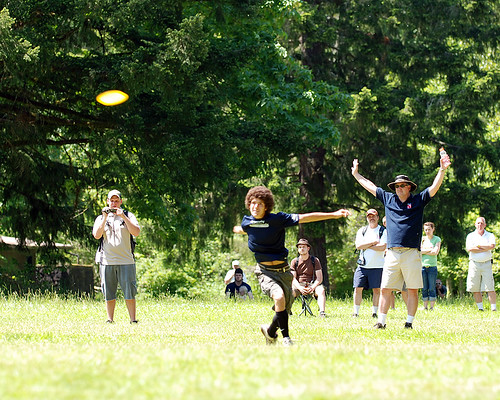
Being at ground zero, so to speak, it was obvious that PDGA communications director and others worked extremely hard to make the first live broadcast (webcast) of a disc golf event (the USDGC) a big success. And I must say, from a production standpoint, they hit it out of the park. I watched the the broadcast team live before and after (and a little bit during, waiting to tee on hole 3) my rounds. But on Thursday, after my round was over, I went back to my hotel room to change and eat, with the intention of heading right back to the course to catch more of the action live. But I never returned that day.
Once I pulled the live feed up on my laptop, I enjoyed it so much I just stayed in my room and watched it for three hours! After all, I can watch disc golf action anytime, right? I thought the course came across as a disc golf version of a manicured private ball golf course (some will say that's a good thing, some won't). The event appeared very professional, with the many spotters with their red and green flags adding greatly to the effect. Looking at the players collectively, the impression was that they appeared more recreational than professional, but I can't say why. I mean, what is a professional disc golfer supposed to look like, anyway? If our sport ever did reach that upper echelon with big corporate sponsors, million dollar purses, and television coverage, what would a professional disc golfer look like? (Warning: Digression Alert)
It's easy to picture a hybrid version of a PGA Tour ball-golfer and our current 'pro' look, with Salomon, Keen, or (New Balance or) Bite shoes, long shorts, dri-fit polo shirt and hat or visor? Or might it look more like Nikko Locastro (the guy in the picture)? He's got three things that give him a unique look: the big 'fro, the tube socks pulled up to the knees, and the fact that often those tube socks are often of different colors. And that unique look may be what gets disc golf the exposure it needs to get over the top.
In terms of awareness, a sport needs to do something noticeable just to get its foot in the door. It's much easier to keep or hold attention that to attain it in the first place. But I digress . . .
My point is that there is a school of thought among some of those involved with the National Tour that if we can just get the sport on TV, everything else will follow. And, led by John Duessler, they trumpeted the webcast as a seminar moment in the development of the sport before the fact. What's more, after the fact they glowed about the fact that 7,000 different people signed up to watch the webcast. I'll admit that the extra fact about those people being in 22 different countries was really cool, but only 7,000 people? I don't think potential 'big fish' advertisers and sponsors are impressed by that number.
I do think disc golf has a big future, but I think it'll likely happen a little differently than that other school of thought. Check back soon, and I'll finish the thought.








No comments:
Post a Comment